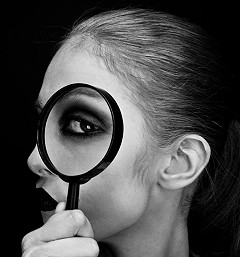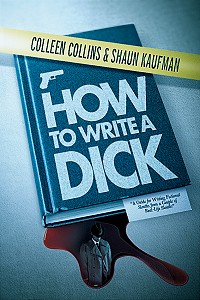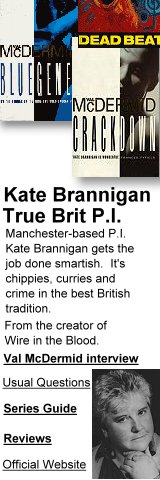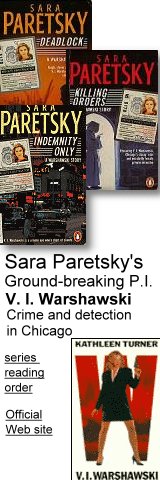Summer 2014-15
Female Private Eyes in Fiction
From Lady Detectives to Hard-Boiled Dames

"I thought it was time for a tough, smart, likeable female private investigator, and that's how V.I. came to life." ~ Author Sara Paretsky about her PI character V.I. Warshawski
Ask people to name one of the first fictional female private eyes, and they might mention Sue Grafton's Kinsey Millhone or Sara Paretsky's V.I. Warshawski, both of whom hit the fiction scene in the early 1980s. Actually, the first female private detective appeared in a story over a hundred years earlier.
Before we step back in time, let's first define a private eye, AKA private investigator (PI) or private detective.
Private Versus Public Detectives
The private eye genre features a private investigator, or PI, protagonist who is a citizen paid to investigate a crime (however, there are times in stories where private eyes work a case for free - for example, the PI feels compelled to solve a good friend's murder). Private investigators are not government employees who work in the public sector, such as police detectives, coroner's office investigators and federal special agents. However, it is not uncommon, in both real life and stories, that retired government investigators start second careers as PIs.
A few examples of private investigators: those who work in solo practices or as employees for a PI agency, reporters, insurance company investigators, and even lawyers in private practice.
Amateur sleuths, however, are not classified as private eye genre as they are not paid for their professional investigative services.
This article categorizes female private detectives into different stylistic eras: Victorian, the Golden Age of Detectives, Hard-Boiled and Contemporary.
Victorian Era Lady Detectives

The Victorians loved crime fiction, which typically reflected their world of dynamic men in society and passive women who stayed at home. However, a few authors challenged those roles in detective fiction.
Many view Mrs. Paschal as the first female private detective in literature. In 1864, Paschal appeared in The Revelations of a Lady Detective, written by W. S. Hayward, a British male writer. Although Mrs. Paschal occasionally worked with the police force, she also conducted private investigations for payment.

In 1894, private detective Miss Loveday Brooke appeared in a collection of stories by Catherine Louisa Pirkis, The Experiences of Loveday Brooke, Lady Detective. The thirtyish Brooke worked for Ebenezer Dyer, head of a private detective agency in London, after being "thrown upon the world penniless and all but friendless." Cut off from the world she once knew, she is a competent investigator who conducts convincing impersonations, traits that are reminiscent of the first real-life woman PI in the US, Kate Warne, who talked her way into being hired as a private detective by the Pinkerton National Detective Agency in 1856.
Golden Age of Detectives: Snobbery with Violence
The Golden Age of Detectives is generally acknowledged as spanning the years 1920 to 1939, although some contain it to the 1920s only. Stories from this era emphasized plot, English settings, and detectives who displayed ingenuity in solving the crimes.
During the early 1920s, Hulbert Footner wrote a series of detective stories featuring Madame Rosika Storey, Private Investigator, whose tales were published in the US, United Kingdom and other countries.

In 1928, writer Patricia Wentworth introduced Miss Maud Silver as a minor character in Grey Mask. In 1937, Silver starred as a professional private detective, although she preferred to be called a private enquiry agent, in The Case Is Closed. Mystery novelist D. L. Browne, AKA Diana Killian, calls Miss Silver "a professional investigator and a stand-up woman, a true forerunner of all future female private eyes."
Private detective Miss Felicity Lemon made her entrance in 1934 as the efficient secretary for Mr. Parker Pyne in Parker Pyne Investigates, a set of short stories by Agatha Christie. Later, Agatha Christie's iconic private detective Hercule Poirot hires Miss Lemon to be his secretary.
Trixie Meehan, created by Thomas Theodore Flynn, worked at the Blaine Private Detective Agency with her partner Mike Harris in stories published in Detective Fiction Weekly: The Deadly Orchid (1933) and The Letters and the Law (1936).
If crime fiction were compared to eggs, this golden era of detectives would be soft-boiled, differentiating it from the hard-boiled private eyes that were starting to emerge in American literature.
Hard-Boiled Lady Dicks

The hard-boiled genre and its detective - AKA shamus, private dick, snoop, gumshoe - took its first steps in the 1920s and hit its stride in the 1930s up through the 1950s. These hard-drinking, wisecracking private eyes walked the mean streets in an urban jungle filled with violence and bloodshed.
Alongside iconic hardboiled private eyes like Sam Spade and Philip Marlowe were their female counterparts in pulp fiction (named for the cheap "pulp" paper on which these stories were printed). A subset of these female private eyes appeared in the "screwball comedy" genre, which included elements of farce, romance and humor. Below is a sampling of these detective dames, their authors and example works:
Grace "Redsie" Culver (created by Roswell Brown, pen name of Jean Francis Webb). Culver appeared in 20 stories in The Shadow Magazine from 1934-1937. As an operative for the Noonan Detective Agency, Culver was one of the first female private eyes to work solo.
In 1934, Nora Charles, who falls into the screwball comedy category, made her debut in The Thin Man, written by Dashiell Hammett in the wake of his hard-boiled classic The Maltese Falcon.
The November 1937 issue of Crime Busters introduced readers to private eye Carrie Cashin, owner of the Cash and Carry Detective Agency in Manhattan. Cashin starred in 38 stories, written by Theodore A. Tinsley, and was the most popular lady dick in the pulps.
Probably the first hardboiled female private eye featured in a novel is Dol Bonner in The Hand in the Glove, written by Rex Stout in 1937. Although this is a standalone book with no sequels, Bonner later returned as a supporting character in several novels featuring Stout's detective Nero Wolfe.
Now let's jump forward in time to the 1970s.
Contemporary Female Private Eyes

Many credit P.D. James for creating the modern female private eye character, Cordelia Gray, in An Unsuitable Job for a Woman (1972). James wrote only one more Cordelia Gray novel before abandoning the character.
Over the next decade, three women writers kicked off popular, multi-book series starring hard-edged female private eyes: Edwin of the Iron Shoes, featuring PI Sharon McCone (1977) by Marcia Muller; "A" Is for Alibi, with PI Kinsey Millhone (1982) by Sue Grafton; Indemnity Only, introducing lawyer-turned-PI V.I. Warshawski (1982) by Sara Paretsky.
Since then, many more female private eyes have taken center stage in novels. Below I list a few of these gutsy, flawed and entertaining gumshoes:
PI Carlotta Carlyle, created by Linda Barnes, made her debut in the short story Lucky Penny (1985), followed by the novel A Trouble of Fools (1987).

Scottish author Val McDermid introduced PI Kate Brannigan in Dead Beat (1992).
In 1994, PI Lydia Chin (partners with PI Bill Smith) came on board in China Trade by S. J. Rozan.
PI Hanne Wilhelmsen, created by Norwegian author Anne Holt, first appeared as a policewoman in Blind gudinne (originally published in Norway,1993; published in the US as Blind Goddess, 2012). In Wilhelmsen's recent crime adventure, 1222, she has retired from the police force and works as a private investigator.
This article merely grazes the landscape of female "eyes" in literature. To read more on this topic, check out the resources under Recommended Reading.
Recommended Reading

Dangerous Dames: A Timeline of Some of the Significant Female Eyes, and the Date of Their First Appearance, The Thrilling Detective website: http://www.thrillingdetective.com/trivia/triv138.html
Hard-Boiled Dames: Stories Featuring Women Detectives, Reporters, Adventurers, and Criminals from the Pulp Fiction Magazines of the 1930s. Bernard Drew, ed., preface by Marcia Muller, St. Martin's Press, 1986. http://www.amazon.com/Hard-boiled-dames-featuring-detectives-adventurers/dp/0312361882
Investigating the Female Detective in Victorian and Edwardian Literature, a review of Sherlock's Sisters: The British Female Detective 1864-1913. Dagni Bredesen, Eastern Illinois University, 2007. http://www.ncgsjournal.com/issue31/bredesen.htm
Women Detectives - Fictional Women PIs Time Chart by Bob Schneider: http://womendetectives.weebly.com/
Free Ebooks: Early Female Private Eyes
The Kidnapping of Madame Storey by Hulbert Footner 1936 (free ebook, Gutenberg Press): http://www.gutenberg.ca/ebooks/footner-kidnapping/footner-kidnapping-00-h.html
The Experiences of Loveday Brooke, Lady Detective by C.L. Pirkis, 1894 (free ebook, Celebration of Women Writers): http://digital.library.upenn.edu/women/pirkis/brooke/brooke.html
© 2014 Colleen Collins, All Rights Reserved.

Colleen Collins is a professional private investigator and award-winning author of over two dozen novels. She also co-authored two nonfiction books with defense attorney Shaun Kaufman: How to Write a Dick: A Guide for Writing Fictional Sleuths from a Couple of Real-Life Sleuths and A Lawyer's Primer for Writers: From Crimes to Courtrooms.
See also:
How to Write a Dick: A Guide for Writing Fictional Sleuths from a Couple of Real-Life Sleuths: (Amazon.com)
A Lawyer's Primer for Writers: From Crimes to Courtrooms: (Amazon.com)
See also in this series:
The Immortal Enduring Vampire by Rhiannon Frater
Get Ready Cyberfunkers: Black Science Fiction by K. Ceres Wright
Defining Horror by Jeani Rector
Steampunk: A Marvellous Excursion by Michael Pryor
Female Private Eyes in Fiction: From Lady Detectives to Hard-Boiled Dames by Colleen Collins
The Good, the Bad and the Ugly: Western Writing by Julia Robb
Grand Tradition Science Fiction: Stories that Want to Have Fun, by Bascomb James
Unintended Invention: The Fantasy of Manners, by Ellen Kushner
For posts about Melbourne events, places, news, reviews, giveaways, see our Facebook Page:









 Published in Melbourne, Victoria, Australia
Published in Melbourne, Victoria, Australia